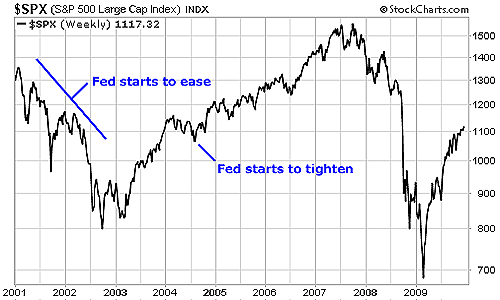| Home | About Us | Resources | Archive | Free Reports | Market Window |
|
Editor's note: Thousands of investors are worried our government's "easy money" policy will stoke inflation soon. This inflation would hammer certain investments, like normally safe bonds. Our friend Frank Curzio, editor of the Penny Stock Specialist (a publication you'll be hearing a lot about in 2010), offers an interesting take on the situation to kick off the New Year...
Why I'm Buying Stocks This YearBy
Monday, January 4, 2010
Right now, it's easy to make the case that sometime this year we'll be in the middle of a stock and credit bubble.
This potential bubble has its roots in the $787 billion American Recovery and Reinvestment Act (ARRA) passed early last year. It's the largest stimulus package in our nation's history. Billions in "free money" is being passed around to the infrastructure, technology, and energy sectors. And only 32% of the stimulus has been spent thus far. Based on the laws of the ARRA, most of the remaining cash must be spent in 2010 and 2011. In other words, there will be a huge amount of cash flowing into companies over the next two years. The surge in gold and commodity prices supports the idea that we'll eventually see inflation and bubbles from the massive government spending... especially with our government throwing money into every problem area of the market. So it would be difficult for any analyst to say they are not concerned about future bubbles or inflation. I certainly am. But here's what I'm about to show you: Bubbles are not created overnight.It could take up to four years before another credit crisis or inflation hits the markets. The fed-funds rate is the interest rate banks charge each other for overnight loans. The Federal Open Market Committee (FOMC) controls the fed-funds rate and may lower it to spur growth or raise it to combat inflation. In March 2001, the U.S. economy slipped into recession. A recession is defined as two consecutive quarters in which gross domestic product (GDP) is negative. To make it easier for businesses to get capital for projects and hiring, the Fed began to lower ("ease") short-term interest rates. The Fed lowered rates more aggressively later in 2001 and into 2002 because consumers were reluctant to spend after the September 11 terrorist attacks. Let's look at the chart of the S&P 500 during that timeframe:  The Fed pushed interest rates to 1% in 2003 and 2004. Notice the huge turnaround during this timeframe in the S&P 500. Lowering the fed-funds rate to unprecedented levels resulted in huge economic growth and a spike in the stock market through 2007. Lower interest rates made lending too easy. Almost anyone on any pay scale could get a mortgage. In 2008, we saw the negative effects of the easy-money policy as the housing and credit bubble popped. The S&P 500 crashed to 666 from a peak of 1,560... That's nearly 60%! But as you can see from the chart, it took roughly four years for the credit and market bubble to burst from the time interest rates were at record lows. So it took about four years from the time when the fed-funds rate was at 1% (2003 to 2004) until the stock market crashed (2008). There is no denying easy money leads to bubbles. But my point is, there's a long time between the boom and the bust. Today is similar to 2004. Interest rates are at historic lows (0% to 0.25%). The stock market is trending higher. Economic data including manufacturing and unemployment bounced off lows. Plus, corporate profits are rebounding. Sure, the creation of new money through stimulus plans coupled with low interest rates will create future bubbles. And I don't expect the time between the next boom and bust cycle to take four years – especially with the deficit at $1.5 trillion and unemployment above historical norms. But it won't happen over the next 12 months either. Not as long as the government keeps the printing press running. Could the bears be right much sooner than I think? Sure... anything can happen. But big shifts in monetary policy and credit flows happen glacially. They take much longer to play out than impatient investors expect. And history suggests this one will take at least a year. That's why I'm bullish on stocks for 2010. Good investing, Frank Curzio
Further Reading:
Today's Biggest Bets Against the Crowd Market Notes
NEW HIGHS OF NOTE LAST WEEK
Cinemark Holdings (CNK)... movie theaters Regal Entertainment (RGC)... movie theaters Walt Disney (DIS)... media & entertainment iShares South Korea (EWY)... backdoor China play U.S. Steel (X)... steel Boston Beer (SAM)... beer Google (GOOG)... search engine Bank of Montreal (BMO)... bank Hewlett-Packard (HPQ)... hardware Tim Hortons (THI)... restaurants Posco (PKX)... Asian steel giant Apple (AAPL)... iPhones and iPods General Mills (GIS)... military-industrial food complex Cameron International (CAM)... oil services Starbucks (SBUX)... expensive coffee Public Storage (PSA)... giant REIT Boston Properties (BXP)... giant REIT Equity Residential (EQR)... giant REIT Vornado Realty Trust (VNO)... giant REIT Simon Property Group (SPG)... giant REIT Chile Fund (CH)... commodity heavy economy TransCanada Corp (TRP)... pipelines Crosstex Energy LP (XTEX)... pipelines DCP Midstream Partners (DPM)... pipelines Claymore Timber ETF (CUT)... timber fund
NEW LOWS OF NOTE LAST WEEK
Not many |
In The Daily Crux
Recent Articles
|

